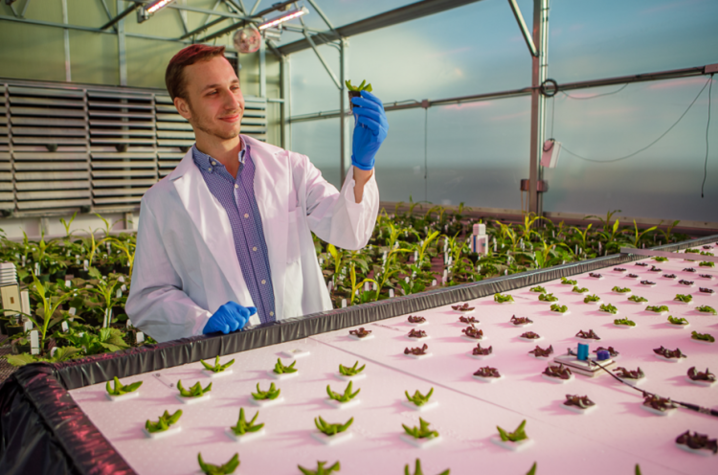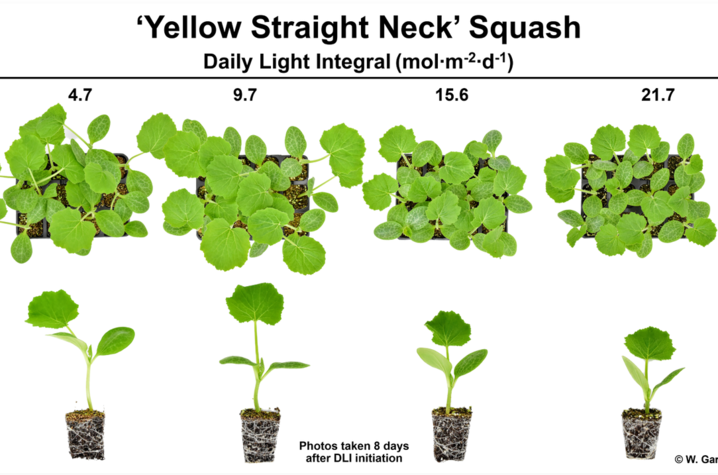Study Aims to Help Kentucky Growers Improve Transplant Quality
LEXINGTON, Ky. (July 21, 2022) — Producing vegetable transplants — small starter plants for growers to begin gardens with — is a “budding” industry in Kentucky. Lark Wuetcher, senior horticulture major in the University of Kentucky College of Agriculture, Food and Environment, is helping Kentuckians address potential industry issues by studying the optimal lighting conditions needed to keep transplants in the Bluegrass healthy and high quality.
Wuetcher’s project focuses on the influence of daily light integral on growth, morphology and quality of vegetable transplants. Garrett Owen, assistant professor in the UK Department of Horticulture and Wuetcher’s adviser for this project, defined daily light integral (DLI) as the cumulative and integrated measurement of light intensity and duration of light exposure a plant receives in a 24-hour period. Owen also said daily light integral changes depending on geographical location, season, day length, greenhouse glazing material and infrastructure, and a variety of other factors.
The goal of the study is to determine the optimal DLI for Kentucky growers to achieve the best transplant quality and to help them learn how to reach and maintain target DLIs throughout the year.
According to the 2017 UK cooperative extension publication “Vegetable Transplant Production,” there is a large demand for vegetable transplants and young plants across the state. All sizes of growing operations, from commercial to home gardens, use transplants.
Owen explained that DLI is especially important in the transplant industry because low light can lead to poorly rooted young plants with an increased likelihood of damaging and breaking transplants during planting.
“Under the optimal DLI, growers can reduce transplant shock and the opportunity for those transplants to be bent in half or snapped, or if there is a producer in the state that produces transplants for other growers, they can easily ship them as well,” Owen said.
Owen surveyed vegetable transplant growers across the state to determine which transplants to include in the study. The survey showed which species may be most beneficial to Kentucky growers, leading researchers to select popular and common species such as cucumber, tomato, bell pepper, eggplant, squash and more.
Wuetcher and Owen are conducting the study at the UK Horticulture Research Farm in Lexington. By manipulating and managing the greenhouse environment over the transplants, Wuetcher and Owen can create different DLIs and document how each vegetable species performs under various DLIs. After about two weeks, the researchers measure and photograph transplants from the different treatments to collect data for comparison and calculations.
“It's satisfying lining up the transplants and seeing the gradual but clear trends between treatments knowing the work paid off with good data,” Wuetcher said.
The duo began the first research cycle in May and wrapped up the second treatment in early July. The third and final repetition will start in late August. The researchers plan to finish the study by October and have publication materials ready by January to give growers time to implement their findings in the spring.
“I hope that growers will understand the importance of DLI and how an environmental factor within the greenhouse can make a big difference in the overall quality of a plant and even their reputation for producing high-quality transplants,” Owen said.
Owen also hopes that this project will be impactful for Wuetcher to demonstrate the skills and knowledge he has gained in his time with the horticulture department.
“I see these capstone projects being not something simple, but something to challenge the student and pull everything they have learned together over the three years,” Owen said. “It's like the keystone of everything that you've learned here at UK.”
Wuetcher said that even though the project is still ongoing, he feels like he has already learned so much.
“Conducting the project is where I learned the most from setting up the experiment to collecting photos and data from the transplants,” Wuetcher said. “Each part has different procedures that can affect the outcome and accuracy of the project, so learning the correct way to do things has been invaluable.”
Wuetcher said that with the experience from this project and the lessons learned, he plans to continue pursuing research in controlled environment horticulture in his post-graduate career.
As the state’s flagship, land-grant institution, the University of Kentucky exists to advance the Commonwealth. We do that by preparing the next generation of leaders — placing students at the heart of everything we do — and transforming the lives of Kentuckians through education, research and creative work, service and health care. We pride ourselves on being a catalyst for breakthroughs and a force for healing, a place where ingenuity unfolds. It's all made possible by our people — visionaries, disruptors and pioneers — who make up 200 academic programs, a $476.5 million research and development enterprise and a world-class medical center, all on one campus.






